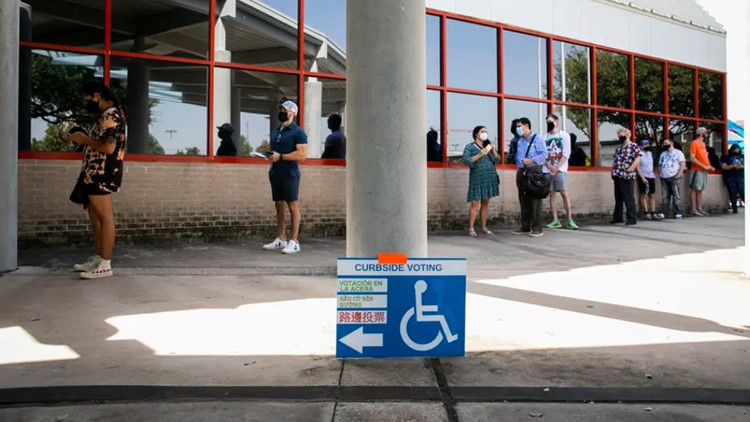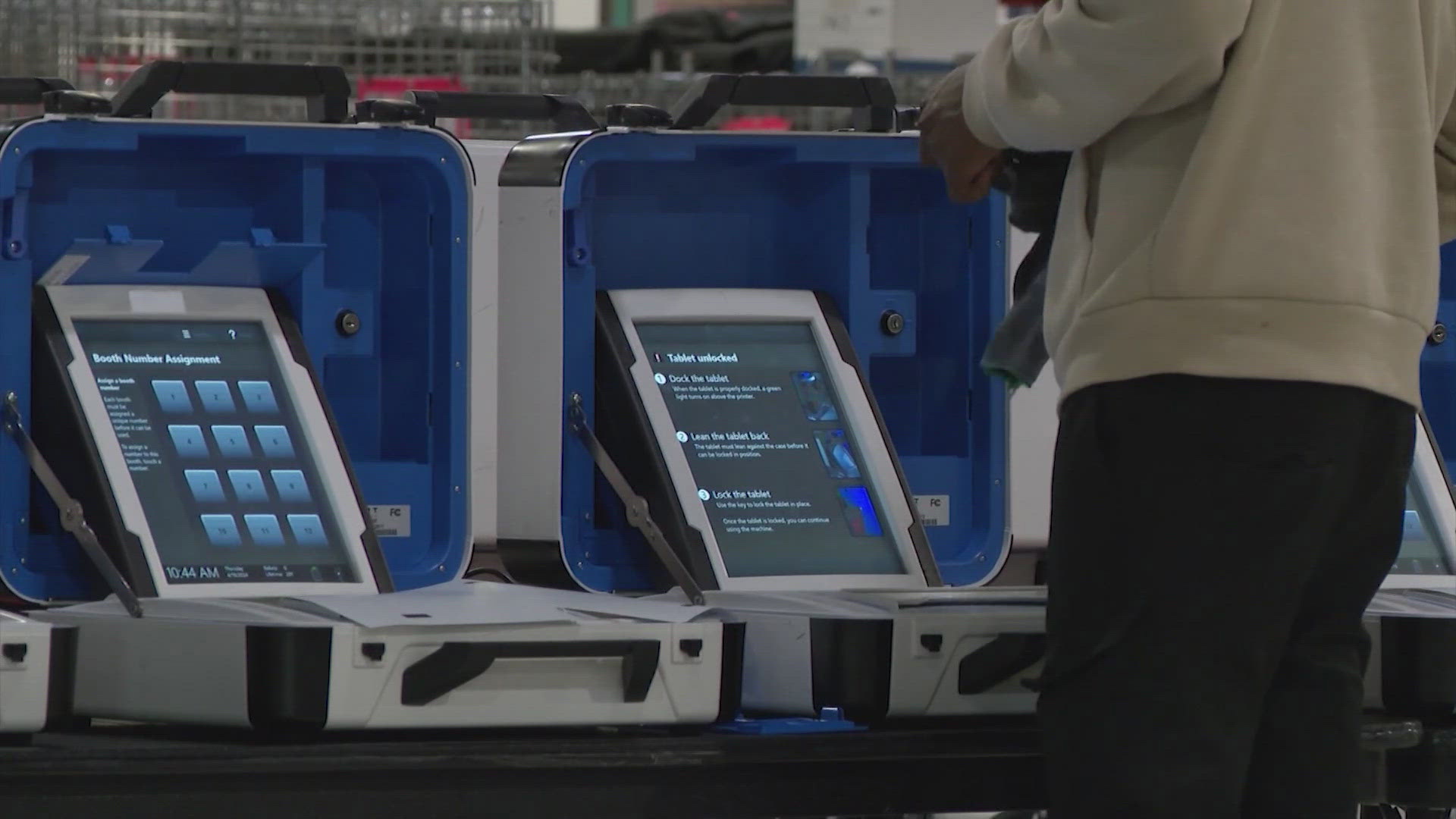TEXAS, USA — Texans are heading to the polls for the 2022 primary, and voters will choose party nominees for statewide seats, including governor, and district-based congressional and legislative seats. Early voting lasts through Feb. 25, and election day is March 1. Historically, voter participation in midterm primary elections is dismal in Texas, with less than a quarter of registered voters casting ballots most years.
Turnout in the 2022 primary was low after the first week of early voting. As of Feb. 21, the turnout data published by the Texas secretary of state does not reflect thousands of mail-in ballots reported by counties on their own websites. A spokesperson for the secretary of state said the office is aware of the discrepancies and working with counties to correct the information. In-person ballots are largely accounted for in the state’s data, although polls were closed on Feb. 21 due to Presidents' Day.
Most Texas voters do not participate in primary elections
Note: This story is from KHOU 11 partners at The Texas Tribune. Click here to look at graphs from the original article comparing voter turnout from previous elections.
What we can and can’t tell from primary turnout
The party that draws more voters in Texas’ open primaries is not a reliable indicator for who will win the general election in November.
“Turnout in the state for primary elections remains perpetually low. But this is true regardless of election year,” said Joshua Blank, the research director of the Texas Politics Project. “It’s not representative or indicative of what’s going to happen in the coming election cycle.”
In the 2020 presidential primary, more Democrats cast ballots than Republicans. But in November, Donald Trump won by 5.6 percentage points in Texas.
Early voting numbers are also not predictive of total turnout. For years, early voting data reported by the state compounded confusion about overall turnout, because it only included data from the 15 counties with the most registered voters. These counties include Texas’ largest cities and the largest concentration of Democratic voters. In 2018, the counties were Harris, Dallas, Tarrant, Bexar, Travis, Collin, Denton, El Paso, Fort Bend, Hidalgo, Montgomery, Williamson, Galveston, Brazoria and Cameron.
During the 2018 primary election, the state initially reported early voting data that showed more Democrats voted early than Republicans. But it was incomplete and when all counties were ultimately tallied; more Republicans had cast votes in the primary.
A law passed in 2019 requires all 254 counties to report who has voted early to the state, allowing the secretary of state to report more complete early voting counts.
Note: Click to the original Texas Tribune article to look at voter turnout in your county for the 2022 Texas primaries.
Primary voters tend to be more engaged in politics compared with the rest of the electorate, whether that involves news consumption or engagement with civic organizations, according to Blank.
Republican primary voters skew white and more conservative than the overall party, and Democratic primary voters skew whiter, more liberal and more suburban than the overall party, Blank added.
In general elections, most Texans vote early
In November general elections, early voting typically outpaces votes cast on Election Day. In 2020, just 13% of votes were cast on Election Day. Before then, in 2016, about one quarter of votes were cast on Election Day. And in 2012, one-third of votes were cast on Election Day. Texas did not track statewide early voting totals in primaries before 2020, so it is not clear if the same trends hold true in primary elections.
Several factors affect turnout rates in any given election. A voter’s access to the nearest polling place is one. The length of the early voting period is another. During the November 2020 general elections, Gov. Greg Abbott extended the early voting period by six days to alleviate crowding at the polls and mitigate the spread of COVID-19. That contributed to a record number of early voters, with more than 9 million ballots cast, or 57.3% of registered voters.
Voter enthusiasm can be a significant driver in turnout rates. More people vote in presidential elections than in midterm elections. Voters are also more inclined to cast their ballots when a race is more competitive. In primary elections, incumbents can make an election less competitive.
Editor's Note: The following video was uploaded on Feb. 14
RELATED: The Texas primary is March 1. Here's what you need to know about early voting and voting day
Texas has a history of low voter turnout
Texas has historically lagged behind other states in voter turnout. According to the 2018 Texas Civic Health Index, a nonpartisan study of civic engagement, Texans had one of the lowest rates of political participation in the state and did not regularly talk about politics.
The state ranked 47th in voter turnout in the 2016 general election, but it has been making gains since then. In the 2020 general election, a record high of about 66% of the 17 million registered voters cast ballots.
In the 2020 primary elections, about 21% of eligible voters in Texas cast ballots, according to the U.S. Election Project. Among the 22 states that have open primaries, meaning voters do not have to declare party affiliation and can choose any party’s ballot, just four states trailed behind Texas in primary voter turnout — Virginia, Tennessee, South Carolina and Arkansas.
The state’s demographics also help explain low voting rate overall, despite its rapid growth. Texas has a large Hispanic population, but Hispanic residents tend to be younger, with a third of the state’s Hispanic population not of voting age and voters under 40 less likely to cast a ballot.
How new voting restrictions could impact voter turnout
This year, Texans will vote under new laws that further restrict the state’s voting process and narrow local control of elections. Counties will have to follow new early voting regulations. Harris County offered 24-hour voting for one day during the 2020 election. The new law bans such measures, restricting early voting hours to 6 a.m. to 10 p.m.
Republicans enacted a handful of voting measures including new ID requirements and rules for voter assistance. Election administrators said they had to return hundreds of vote-by-mail applications and request corrections due to new identification requirements. And while most mail-in ballots have not yet arrived or been processed, election administrators are now also having to reject completed ballots because they were missing an ID number.
Editor's Note: The following video was uploaded on Feb. 9
How redistricting could impact voter turnout
Texas lawmakers redrew maps for the state House and Senate, congressional delegation and State Board of Education, locking in GOP power for the next decade. The maps dilute the voting powers of Texans of color — even though new census data shows people of color are driving population growth.
Redistricting is expected to result in less competitive races between Republicans and Democrats in November. New maps have resulted in more uncontested primary races, meaning only one major political party has a candidate.
In roughly one-third of all political seats up for election in Texas this year, primaries are the only election because the one major party didn’t field a candidate. Out of 150 Texas House seats, there are no Democratic candidates for 41 seats and no Republican candidates for 27 seats. In the 31-seat Texas Senate, eight seats do not have Democratic candidates and three do not have Republican candidates. For the U.S. House, there are no Democratic candidates in six out of 38 seats.
Check the Texas Tribune to see which district your home is in.
Editor's Note: The following video was uploaded on Dec. 6, 2021



